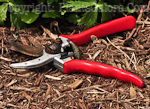-
 Dormant Season - Most
deciduous trees are best pruned after their leaves
have dropped in the fall and before new growth
begins in the spring. When the leaves are gone, it
is easier to see the structure of the tree and to
imagine the long term results of the pruning. Also,
the absence of leaves reduces the weight of the
branches and the amount of material to dispose of
after the pruning.
Dormant Season - Most
deciduous trees are best pruned after their leaves
have dropped in the fall and before new growth
begins in the spring. When the leaves are gone, it
is easier to see the structure of the tree and to
imagine the long term results of the pruning. Also,
the absence of leaves reduces the weight of the
branches and the amount of material to dispose of
after the pruning.
-
Bleeders - Certain
trees such as
maples,
birch and
beech will "bleed"
or seep sap from the wound if they are pruned late
in the winter. This is when maple syrup is gathered
so you know the sap is running. These trees are
better pruned in the early summer after the first
flush of new growth. However, the bleeding is not a
serious stress on the tree and is mostly an
aesthetic concern from the stain it might leave as
it drips down the bark.
-
 Spring Flowering
Trees or Shrubs - Shrubs that flower in April or May
such as
lilacs,
forsythia,
rhododendrons and others
are plants that set their flower buds in the
previous autumn. Therefore, pruning in the dormant
season will only remove flower buds and decrease the
amount of bloom. These types of plants should be
pruned immediately after they stop pruning. Of
course, pruning them at other times will not hurt
the plants, only decrease their flowering.
Spring Flowering
Trees or Shrubs - Shrubs that flower in April or May
such as
lilacs,
forsythia,
rhododendrons and others
are plants that set their flower buds in the
previous autumn. Therefore, pruning in the dormant
season will only remove flower buds and decrease the
amount of bloom. These types of plants should be
pruned immediately after they stop pruning. Of
course, pruning them at other times will not hurt
the plants, only decrease their flowering.
-
Summer Flowering
Trees or Shrubs - Plants that bloom in mid to late
summer usually develop their flower buds in the
spring. They may be pruned during the dormant
season.
-
Either Before or After Flowering
-
Red Oaks - Members of
this branch of the
oak family are susceptible to a
serious fungal disease called
oak wilt. The disease
is spread primarily by
bark
beetles moving from tree
to tree. They are attracted to new, wet wounds.
Therefore, these trees should only be pruned during
the dormant season when the insects are not active.
-
Pinching
- Pruning to increase the branching of the plant.
-
Deadheading
- Pruning off the spent flowers.
-
Rejuvenation
- Pruning to encourage new growth on plants.
-
Vines - Pruning for
optimum flowers (Clematis)
and to keep them in place.



